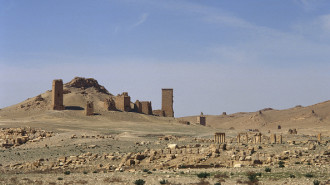Ancient humans hid in Saudi Arabian lava tube for over 7,000 years
Researchers have unveiled a groundbreaking find in Saudi Arabia that shows a rare glimpse into the lives of early desert dwellers.
Griffith University’s Australian Research Centre for Human Evolution (ARCHE) found evidence of human life in a lava tube in Saudi Arabia that was inhabited over 7,000 years ago.
A lava tube is a natural underground tunnel or passage formed by molten lava flowing from a volcanic eruption. As the lava cools and solidifies on the outer edges, it creates a tunnel-like structure.
Lava caves have not been intricately investigated archaeologically in Saudi Arabia until now.
The site, Umm Jirsan, indicates the use of herding and agriculture, painting a detailed picture of the region’s pastoral history through its records.
The early inhabitants left behind a wealth of artefacts, which included rock art, stone tools and animal bones.
Researchers also noted how the site was continually used through various prehistoric periods from the Neolithic through the Bronze Age.
Backed by Saudi authorities, the initiative aims to continue decades of research that could unravel and revolutionise what we know about the Middle East’s ancient history of human activity.
"While underground localities are globally significant in archaeology and Quaternary science, our research represents the first comprehensive study of its kind in Saudi Arabia," said Professor Michael Petraglia, Director of ARCHE.
"Our findings at Umm Jirsan provide a rare glimpse into the lives of ancient peoples in Arabia, revealing repeated phases of human occupation and shedding light on the pastoralist activities that once thrived in this landscape," Mathew Stewart, the lead researcher and a Research Fellow at ARCHE, added.
"This site likely served as a crucial waypoint along pastoral routes, linking key oases and facilitating cultural exchange and trade."

![Archaeologists conduct an excavation at Saudi Arabian site Umm Jirsan [Griffith University]](/sites/default/files/styles/large_1_1/public/2024-04/jIpJRDva.jpeg?h=d36fc48b&itok=QmJApDD3)



 Follow the Middle East's top stories in English at The New Arab on Google News
Follow the Middle East's top stories in English at The New Arab on Google News

![A group of Palestinians, foreign and Israeli activists gather to participated in an olive picking event on the land in the town of Battir, which is under threat of confiscation by Israel in Bethlehem, occupied West Bank on 8 November 2024. [Getty]](/sites/default/files/styles/image_330x185/public/2182930803.jpeg?h=199d8c1f&itok=__0LgGsa)
